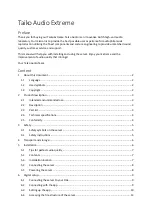
Section 3: Working with devices and instruments
Model 8010 High Power Device Test Fixture User's Manual
3-26
8010-900-01 Rev. C / March 2017
The next figure shows how to perform an open connection test without a device inserted:
Figure 36: Model 8010 CVU-200-KIT 2-term DUT terminal open connection
The next figure shows how to perform a short connection test without a device inserted and how to
install a short between the fixture terminals:
Figure 37: Model 8010 CVU-200-KIT 2-term DUT terminal short connection
Optimizing cables and connections for high voltage C-V
measurements
Successful C-V measurements require a precise coaxial cabling setup. The Model 4210-CVU
capacitance–voltage instrument is a four-terminal instrument that includes remote sense capability. A
C-V meter includes an AC voltage source and an AC ammeter. The sense leads are used to maintain
the voltage at the device terminals. As with all AC measurements, ensure a good connection between
the shields of all the terminals at the DUT. The integrity of this connection becomes increasingly
important with an increase in the testing frequency. The connection between the shields forms an
inductive loop that is directly inserted in the measurement path. Tie the cable shields together as
close as possible to the DUT in order to minimize the inductive loop area.
The 8010 C-V measurement with the bias tees is a 2-wire measurement. Do not connect the Sense
HI and Sense LO terminals to the DUTs or enable 2-wire (local) sense at the SMU instrument only.
















































